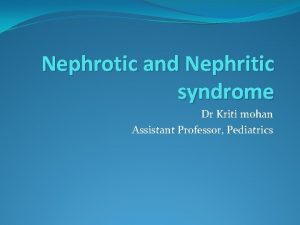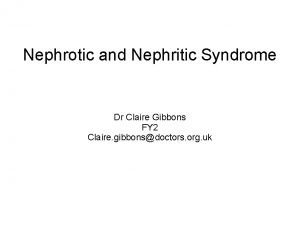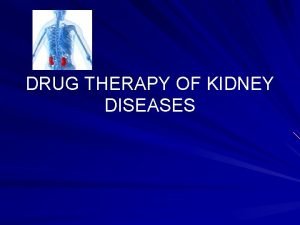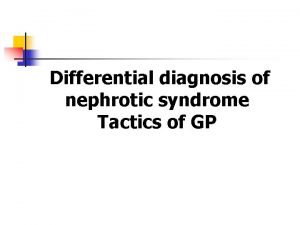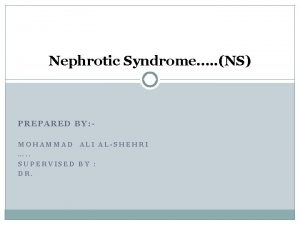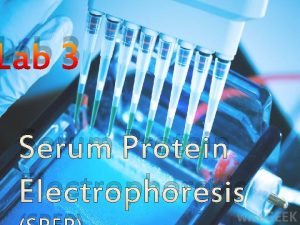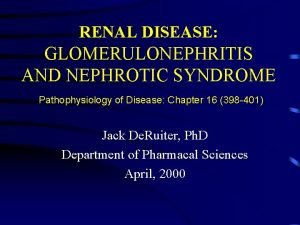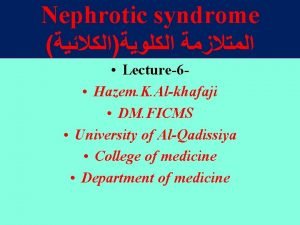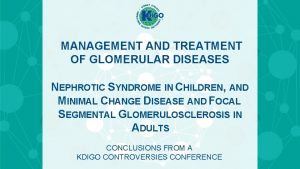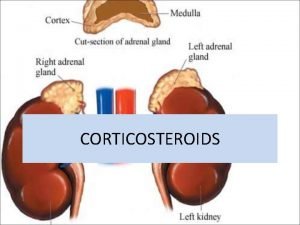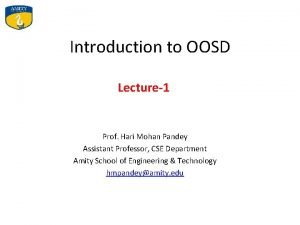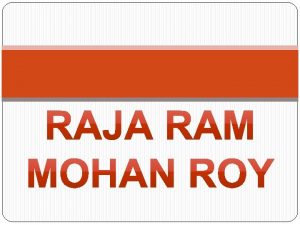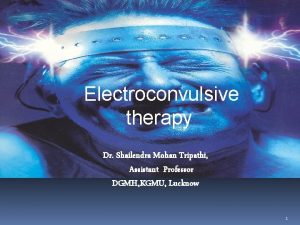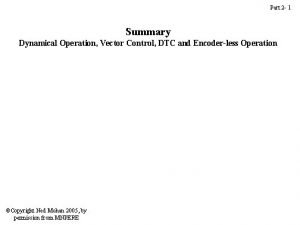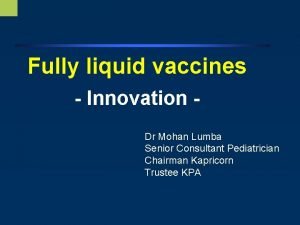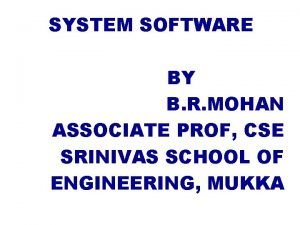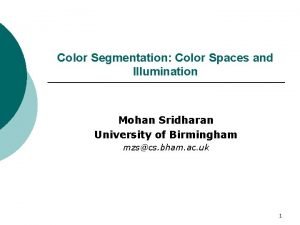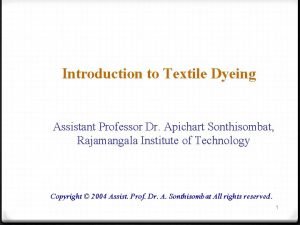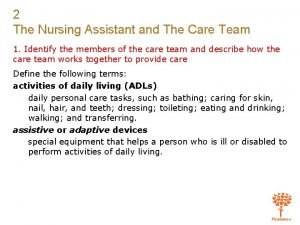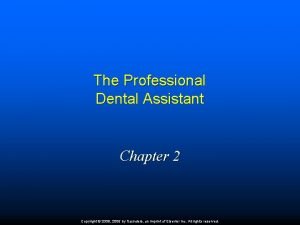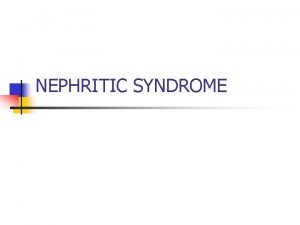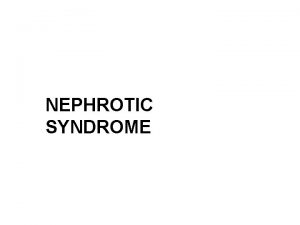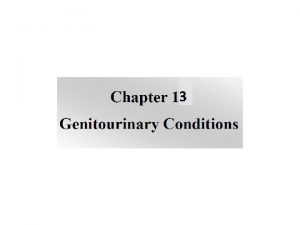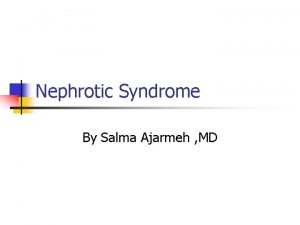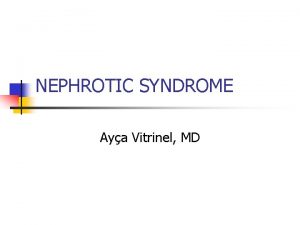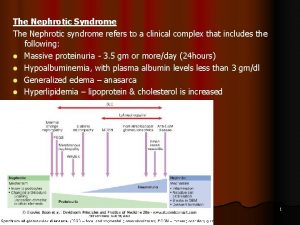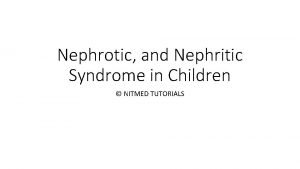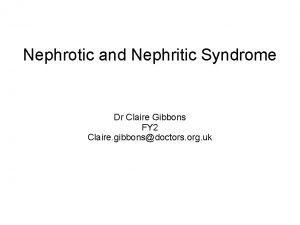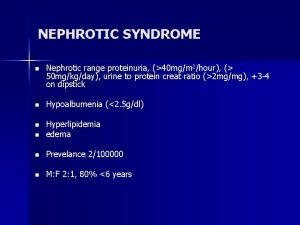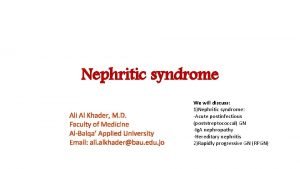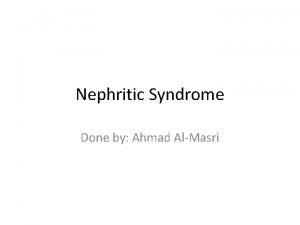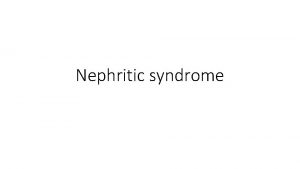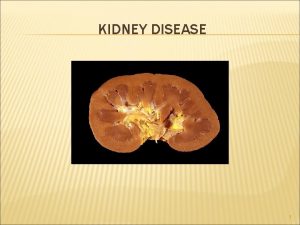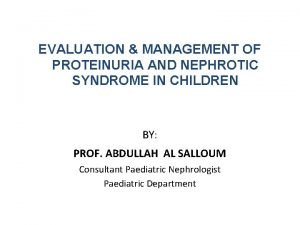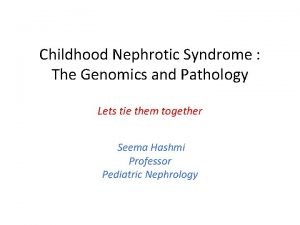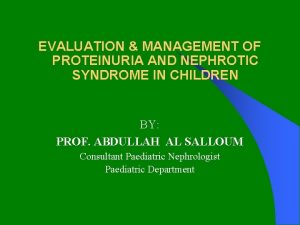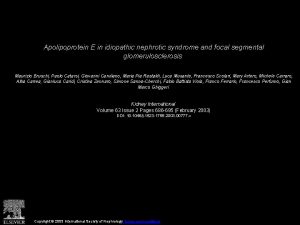Nephrotic and Nephritic syndrome Dr Kriti mohan Assistant











































- Slides: 43

Nephrotic and Nephritic syndrome Dr Kriti mohan Assistant Professor, Pediatrics

Learning objectives �Definition of Nephrotic syndrome �Etiopathogenesis of nephrotic syndrome �Clinical manifestation �Evaluation �Management �outcome �Post streptococcal GMN

Introduction �Important chronic disease in children � 80% children show remission with steroid �Most patients have multiple relapses

Definition �Heavy proteinurea>3. 5 gm/24 hr or >40 mg/m 2/hr in children �Hypoalbunemia <2. 5 gm% �Oedema �Hyperlipidemia (serum cholestrol>200 mg/dl)

Nephrotic range proteinurea �Early morning protein is 3+/4+ (dipstick or boiling test) �Spot protein/creatinine ratio >2 mg/mg or �Urine albumin excretion >40 mg/m 2 per hr (on a timed-sample).

Etiology �Idiopathic: 90% � minimal change 85%, mesangial proliferation , FSG , membranoproliferative, congenital (Finnish type) �Secondary: 10% �SLE, anaphylactoid purpura, sickle cell disease, Hodgkin lymphoma, diabetes mellitus, amyloidosis, malaria (P. malariae), intrauterine infections (syphilis, toxoplasmosis, cytomegalovirus) and other infections like HIV, parvovirus B 19, hepatitis B and C virus, drugs like d-penicillamine, gold and toxins or allergies (bee sting, poison ivy, food allergy).

Pathophysiology �Increase in permeability of glomerular BM �T- cell dysfunction �Mechanism of edema: �Urine protein loss leads to hypoalbuminemia decreased oncotic pressure transudation of fluid �Reduction in intravascular volume and decrease renal perfusion pressure

Pathophysiology �Mechanism of lipid elevation: �Hypoalbuminemia stimulates generalized hepatic protein synthesis including lipoprotein �Lipid catabolism is diminished due to decrease in lipoprotein lipase

Clinical Features clinical Minimal change disease Mesangial proliferation Focal segmental glomerulosclero sis Incidence 85% 10% 5% Age at presentation 2 -6 years 2 -10 years Hypertension 10% 10 -45% 35 -45% Microscopic Hematuria 10 -20% 45 -90% 60 -80% Response to prednisolone 95% 50 -60% 20 -30% Likelihood of maintaining renal function 95% 50 -60% 20 -30%

Cont… clinical Minimal change disease Mesangial proliferation Focal segmental glomerulosclero sis Light Microscopy Normal Increase in mesangial cells Focal or segmental glomerular hyalinization Immunofluoresce- Normal nt microscopy Negative or variable Ig. M and C 3 deposition Focal or segmental deposition of Igm and C 3 Electron microscopy Increase in mesangial cells and matrix, small scattered electron dense deposits in mesangium Fine granular deposits in subendothelial regions Fusion of foot processes of podocytes

Initial evaluation �Detailed evaluation �The height, weight and blood pressure should be recorded �Regular weight record �Physical examination is done to detect infections and underlying systemic disorder � Infections should be treated before starting therapy with corticosteroids.

Investigations �Urinalysis �Complete blood count �Blood levels of Proteins, lipids, urea and creatinine and electrolytes �ASLO and C 3: gross hematuria �Appropriate test –Hb. SAg, HIV and tuberculosis �Renal biopsy

Indications for kidney biopsy �At Onset � Age of onset <1 year or >10 years �Gross hematuria, persistent microscopic hematuria or low serum C 3. �Sustained hypertension. �Renal failure not attributable to hypovolemia. �Suspected secondary causes of nephrotic syndrome. �After Initial Treatment �Proteinuria persisting despite 4 -weeks of daily corticosteroid therapy. �Before treatment with cyclosporin A or tacrolimus.

Management of Nephrotic syndrome �Relief of edema �Hypertension �Identify and treat infection �Specific treatment regimen �Complication


Definition related to nephrotic syndrome �Remission: Urine albumin nil or trace (or proteinuria <4 mg/m 2/h) for 3 consecutive early morning specimens. �Relapse: Urine albumin 3+ or 4+ (or proteinuria >40 mg/m 2/h) for 3 consecutive early morning specimens, having been in remission previously. �Infrequent relapses: <2 relapses in 6 months of initial response or <4 relapses within any 12 months period. �Frequent relapses: Two or more relapses in initial six months or more than three relapses in any twelve months.

Definition related to nephrotic syndrome �Steroid dependence Two consecutive relapses when on alternate day steroids or within 14 days of its discontinuation. �Steroid resistance Absence of remission despite therapy with daily prednisolone at a dose of 2 mg/kg per day for 4 weeks

Treatment of initial episode �Oral prednisolone � 2 mg/kg/day 6 weeks � 1. 5 mg/kg/EOD 6 weeks

Treatment of infrequent relapse �Prednisolone 2 mg/kg/day till remission and then �Prednisolone 1. 5 mg/kg/day for 4 weeks

Treatment of frequent repalse or steroid dependent �Low dose steroids with�Levamisole �Cyclophosphamide �Calcineurin inhibitor : Cyclosporin, Tacrolimus �Mycophenolate mofetil (MMF)


Toxicity of drugs Side effects of prednisolone �Hirsutism �Obesity �Hypertension �Behavioral problems �Cataracts �Striae �Growth failure

Side effects of Levamisole �The chief side effect of levamisole is leukopenia �Flu-like symptoms, �Liver toxicity �Convulsions and skin rash are rare � The leukocyte count should be monitored every 12 -16 weeks.

Side effects of Cyclophosphamide �Leucopenia �Hemorrhagic cystitis �Alopecia �Skin rash �Nausea

Side effects of Cyclosporin �Hypertension �Cosmetic symptoms �Gum hypertrophy �Hirsutism �Nephrotoxicity �hypercholesterolemia and elevated transaminases may occur �Estimation of blood levels of creatinine is required every 2 -3 months and a lipid profile annually.

Side effects of MMF �Gastrointestinal discomfort, diarrhea and leukopenia. �Leukocyte counts should be monitored every 1 -2 months �Treatment is withheld if count falls below 4000/mm 3.

Choice of agent �Few studies comparing one study with another �Levamisole has a modest steroid sparing effect and is a satisfactory initial choice �Treatment with cyclophosphamide is preferred in patients showing: I. significant steroid toxicity II. severe relapses with episodes of hypovolemia or thrombosis, and III. poor compliance or difficult follow up

Complications �Infection �Thrombosis �Hypertension �Hypovolumic shock �Corticosteroid side effects �Malnutrition


Outcome �Steroid responsive - >90% �Relapses- >70% �Mortality – 2 -5%

Patient and parents education �Urine examination at home �Maintain diary showing result of urine protein �Ensure normal activity and school attendance �Appropriate immunization

Acute glomerulophritis �Glomerulonephritis refers to a group of glomerular diseases characterise by inflammatory changes in the glomeruli and manifesting as acute nephritic syndrome which is characterized by�Abrupt onset of hematuria �Oligouria �Edema �Hypertension �Subnephrotic range proteinuria �Azotemia

Causes of Acute GMN �Post infectious: Bacterial-Streptococcal, staphylococcal, pnemococcal, meningococcal. Bacterial endocarditis, infected ventriculoatrial shunt and prosthesis can cause acute GMN. Viral- Hepatitis B and C, mumps, HIV, varicella, infectious mononucleosis. Parasitic- malaria and toxoplasmosis �Systemic vasculitis: HSP, SLE, PAN, Wegner’s granulomatosis

Pathogenesis Immune complex mediated disease i. Immune complex Glomerulonephritis (70%) § Low serum complement C 3 - poststreptococcal, rapidly progressive, mesangioproliferative glomerulonephritis, SLE, bacterial endocarditis, cryoglobulinemia § Normal serum complement C 3 - Ig. A nephropathy, H-S purpura ii. Pauci-immune glomerulonephritis (30%) Anti-neutrophil cytoplasmic antibody positive wegener’s granulomatosis, polyarteritis nodosa iii. Anti GBM disease(<1%) Anti-glomerular basement membrane antibody positive Good pasture syndrome.

Post streptococcal Glomerulonephritis �Following group A beta-hemolytic streptococci �School age children �Boys are more frequently affected

Etiology �Follows a pharyngeal or cutaneous infection by the nephritogenic strains of β hemolytic Group A streptococcus 1 to 4 week preceding streptococcal throat/skin infection �Strain M type 1, 4 and 12 causing pharyngitis and 49, 55, 57 and 60 causing pyoderma �Typical example of immune complex disease

Pathogenesis �Immune complex deposition �Glomeruli enlarged �Ischemia �Capillary wall narrowing �Deposits of Ig. G and C 3

Clinical feature �Rare below 3 years of age �Acute onset �Latent period: Following pharyngitis- 1 to 2 weeks and following cutaneous infection- 2 to 4 weeks �Puffiness around eye and pedal edema �Cola colored urine �Oliguria �Hypertension �Atypical presentation : Convulsion, Pul edema, ARF, CHF �Course of the disease- acute phase: 4 -10 days, azotemia and hypertension: persist for 2 weeks, gross hematuria: 1 -2 weeks

Laboratory investigations � Urine : 1+/2+ protein, dysmorphic RBC’s, and red cell, leukocyte or granular cast, nephrotic range poteinuria in < 5% cases � Hemogram: Anemia, mild leucocytosis, ESR↑ � Biochemistry: C 3 (normal- 77 -195 mg/ d. L) becomes normal in 6 to 8 weeks. � Evidence of streptococcal infection: Throat swab culture, elevated ASO ( for pharyngeal infection+ve in 80%), elevated antideoxyribonucleases-B antihyaluronidase antibodies ( for cutaneous infection), streptozyme test � Others- X- ray chest, ECG � renal biopsy- to exclude other diseases in patients withØ ARF Ø normal C 3 level Ø without evidence of preceding streptococcal infection Ø persistant gross hematuria and hypertension (>3 weeks) Ø prolonged diminished renal functions (> 2 weeks) Ø persistent low serum C 3 (>8 weeks)

Management Presence of ARF and Hypertension requires hospitalisation �Bed rest �Diet �Weight �Fluid restriction �Antibiotics �Diuretics �Alkalinization of urine �Hypertension �LVF �ARF

Outcome and prognosis �Overall excellent prognosis( >95% complete recovery, <1% develop RPGN)) �Symptoms resolves within 1 month �Gross hematuria and proteinuria disappear within 2 weeks �Microscopic hematuria may last for years �Recurrence rare

Difference between acute nephritis and nephrotic syndrome Acute nephritis Nephrotic syndrome � Characterized by hematuria, edema, hypertension, oligouria � Characterized by heavy proteinuria, hpo albuminemia, edema, hyperlipidemia � 90% post infective, immune complex � 90% idiopathic � Usually only 1 attack � Immune complex deposition � Relapses common � Retraction of epithelial foot process � Urine: Alb 1+/2+, hematuria, RBC cast � Blood urea/creat raised � Urine: Selective proteinuria, No RBC � Blood urea/ creat normal

Thank you
 Tacrolimus minimal change disease
Tacrolimus minimal change disease Primary and secondary contracted kidney
Primary and secondary contracted kidney Primary and secondary causes of nephrotic syndrome
Primary and secondary causes of nephrotic syndrome Nephrotic syndrome
Nephrotic syndrome Why there is hyperlipidemia in nephrotic syndrome
Why there is hyperlipidemia in nephrotic syndrome Minimal change disease treatment
Minimal change disease treatment Protein electrophoresis interpretation
Protein electrophoresis interpretation Nephrotic syndrome
Nephrotic syndrome Nephrotic syndrome
Nephrotic syndrome Nephrotic syndrome in child
Nephrotic syndrome in child Corticosteroid classification
Corticosteroid classification Minimal change
Minimal change Kara potter
Kara potter Progeria
Progeria Kriti kacker
Kriti kacker What is oosd
What is oosd Alok mohan md
Alok mohan md Izzy abbott
Izzy abbott Www.mohanscience.lk
Www.mohanscience.lk Seshadri mohan
Seshadri mohan Raja ram mohan roy foundation
Raja ram mohan roy foundation Raja ram mohan roy grave
Raja ram mohan roy grave Lauren mohan
Lauren mohan Mohan dhall
Mohan dhall Mohan sabaratnam
Mohan sabaratnam Contraindications of ect
Contraindications of ect Phonocardiography definition
Phonocardiography definition Ned mohan
Ned mohan Dr mohan lumba
Dr mohan lumba Aswathy mohan architect
Aswathy mohan architect Kannan mohan baruch
Kannan mohan baruch Mohan sridharan
Mohan sridharan Mohanscience
Mohanscience Maureen mohan
Maureen mohan Assistant scorer
Assistant scorer Good morning madam. may i help you
Good morning madam. may i help you Conversation in a shop
Conversation in a shop Printing and dyeing assistant
Printing and dyeing assistant Ethical and legal issues affecting the nursing assistant
Ethical and legal issues affecting the nursing assistant Chapter 2 the nursing assistant and the care team
Chapter 2 the nursing assistant and the care team Describe the care team and the chain of command
Describe the care team and the chain of command The sign makers assistant
The sign makers assistant Workkeys applied mathematics level 5 answers
Workkeys applied mathematics level 5 answers The adaa was formed in 1924 by:
The adaa was formed in 1924 by:
